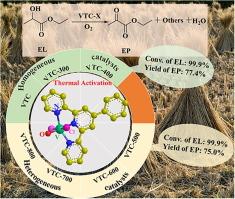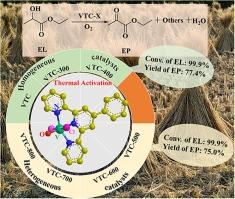新型钒络合物调节乳酸乙酯的均相和异相选择性氧化作用
IF 6.5
1区 化学
Q2 CHEMISTRY, PHYSICAL
引用次数: 0
摘要
作为生产丙酮酸乙酯(EP)的一种绿色和可持续的替代方法,乳酸乙酯(EL)的选择性有氧氧化仍然面临着催化效率低、反应条件苛刻和催化剂不稳定等问题。本文设计并合成了一种新型结晶钒基配位化合物(VTC=VPTPYCl2(H2O), PTPY = 4′-苯基-2,2′:6′,2′'-三联吡啶)。通过在不同温度下活化 VTC,开发了一种高效均相催化体系(VTC-400-O2-CH3CN,400 代表活化温度)和一种可回收的异相体系(VTC-500-O2-CH3CN),使用分子氧作为氧化剂将 EL 液相转化为 EP。在 VTC-400-O2-CH3CN 系统中,EL 可在 4 小时内完全转化,EP 的收率为 77.8%,优于目前已报道的催化系统。同时,异相 VTC-500 催化剂也能在 4 小时内促进 EL 的完全转化,其活性在使用 10 次后基本保持不变。结构表征显示,可溶性 VTC 在 400 ℃ 的较低活化温度下会断裂弱配位 V-Cl 键,从而暴露出更多的钒基催化位点,但配体框架保持不变。然而,有机衍生碳骨架在较高温度(500 ° C)下可有效限制钒基活性物种,防止催化剂溶解,从而推动均相催化体系向异相催化体系过渡。本文章由计算机程序翻译,如有差异,请以英文原文为准。


Homogeneous and heterogeneous selective oxidation of ethyl lactate regulated by a novel vanadium complex
As a green and sustainable alternative for producing ethyl pyruvate (EP), the selective aerobic oxidation of ethyl lactate (EL) is still facing issues such as low catalytic efficiency, harsh reaction conditions and catalyst instability. Herein, a novel crystalline vanadium-based coordination compound (VTC=VPTPYCl2(H2O), PTPY = 4′-phenyl-2,2′:6′,2′’-terpyridine) has been designed and synthesized. A highly efficient homogeneous catalytic system (VTC-400-O2-CH3CN, 400 represents the activation temperature) and a recyclable heterogeneous system (VTC-500-O2-CH3CN) for the liquid-phase conversion of EL to EP are developed using molecular oxygen as oxidant through activating VTC at different temperature. In VTC-400-O2-CH3CN system, EL can be completely converted within 4 h, and the yield of EP is 77.8 %, which outperforms the state-of-art reported catalytic system. Meanwhile, the heterogeneous VTC-500 catalyst can also promote the full conversion of EL within 4 h, and its activity remains basically unchanged after being used for 10 times. Structural characterization reveals that the soluble VTC breaks the weak coordination V-Cl bonds at a lower activation temperature of 400 ° C to expose more vanadium-based catalytic sites, but the framework of ligand remains intact. However, the organic derived carbon skeleton at higher temperature of 500 ° C can effectively confine the V-based active species and prevent the dissolution of the catalyst, which impels the transition of the homogeneous to heterogeneous catalytic system.
求助全文
通过发布文献求助,成功后即可免费获取论文全文。
去求助
来源期刊

Journal of Catalysis
工程技术-工程:化工
CiteScore
12.30
自引率
5.50%
发文量
447
审稿时长
31 days
期刊介绍:
The Journal of Catalysis publishes scholarly articles on both heterogeneous and homogeneous catalysis, covering a wide range of chemical transformations. These include various types of catalysis, such as those mediated by photons, plasmons, and electrons. The focus of the studies is to understand the relationship between catalytic function and the underlying chemical properties of surfaces and metal complexes.
The articles in the journal offer innovative concepts and explore the synthesis and kinetics of inorganic solids and homogeneous complexes. Furthermore, they discuss spectroscopic techniques for characterizing catalysts, investigate the interaction of probes and reacting species with catalysts, and employ theoretical methods.
The research presented in the journal should have direct relevance to the field of catalytic processes, addressing either fundamental aspects or applications of catalysis.
 求助内容:
求助内容: 应助结果提醒方式:
应助结果提醒方式:


